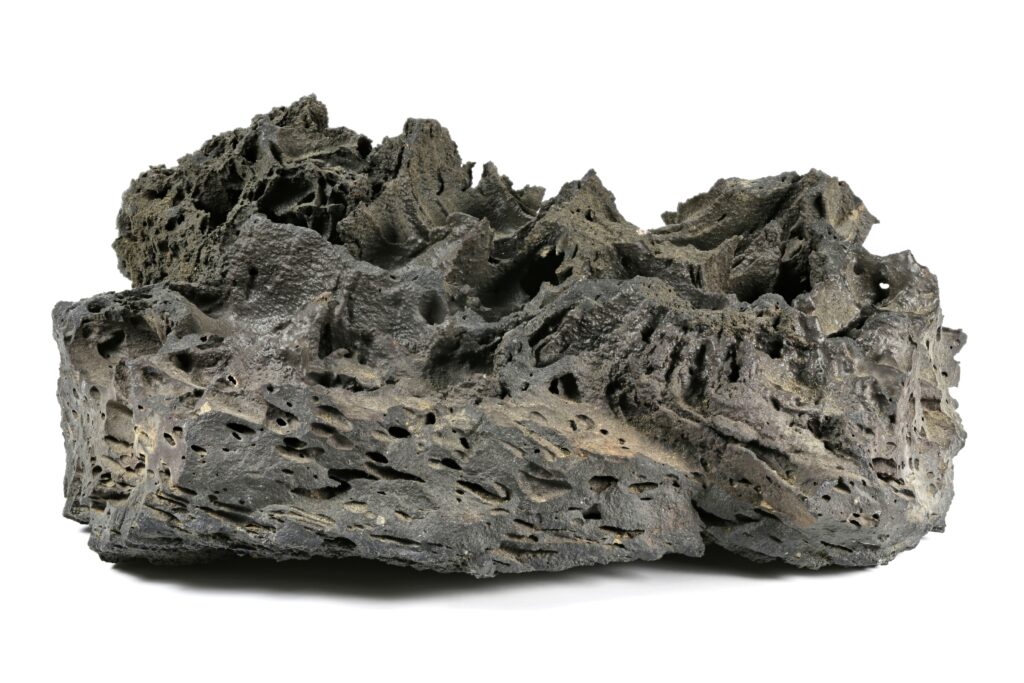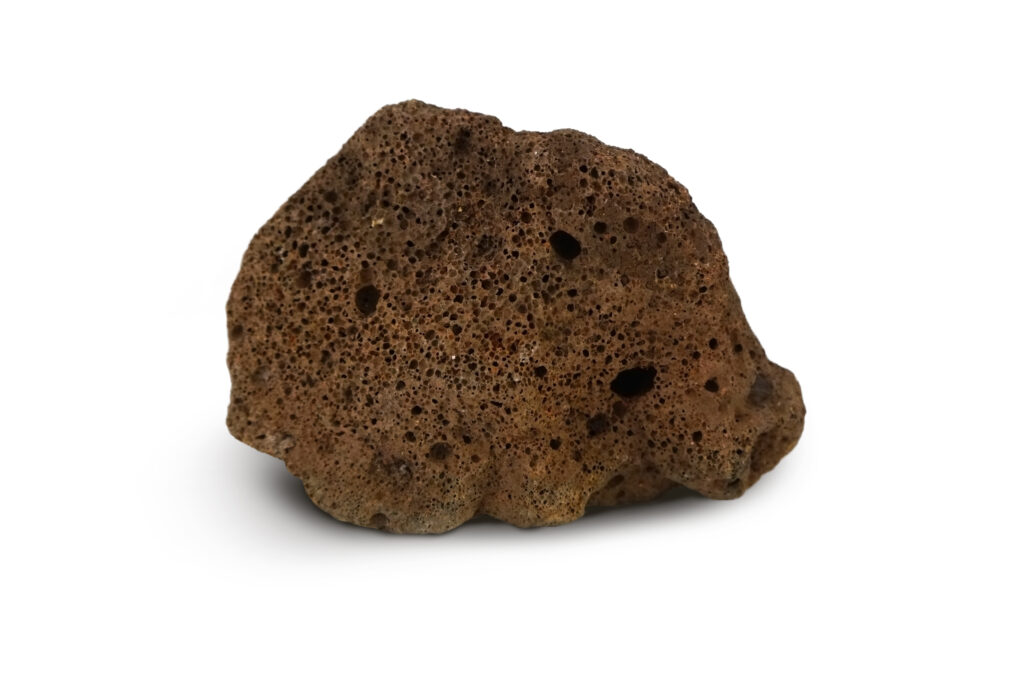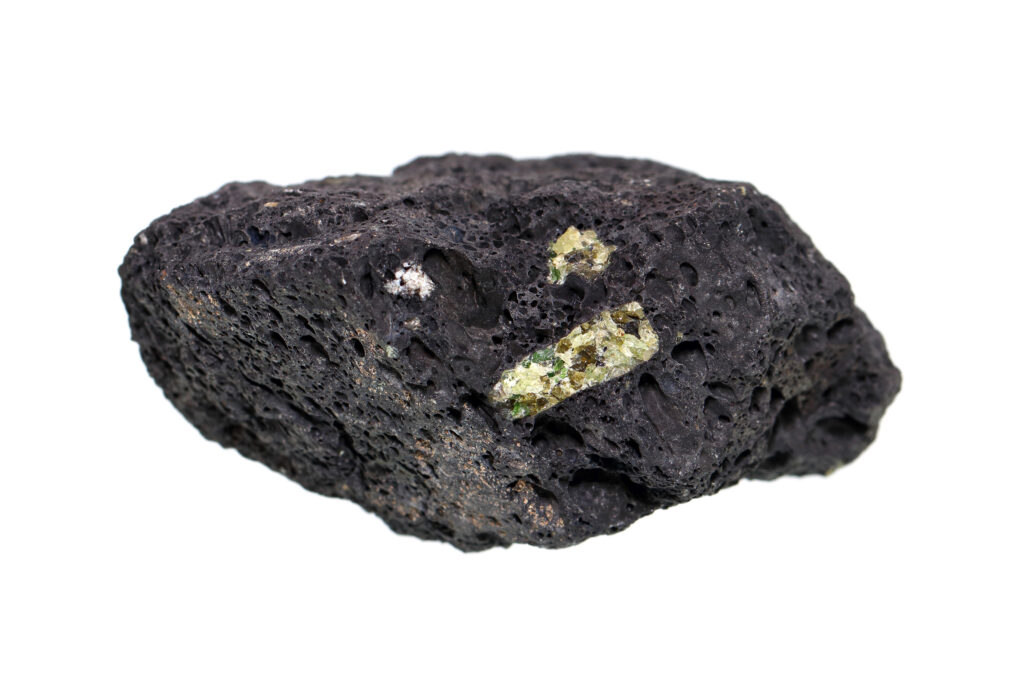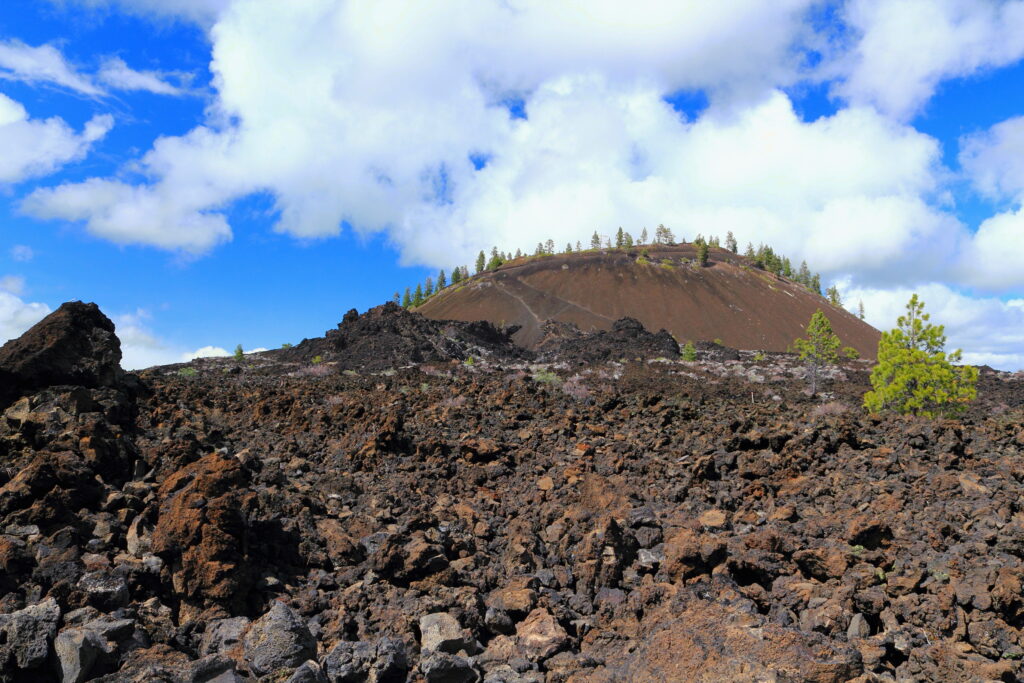Scoria is one of the most distinct and unique rock types found anywhere in the world, but it is often confused for pumice. This comes as no surprise since the two rock types are very closely related, but they are two distinct rock types that should be treated as such. Scoria is worth learning more about due to its prevalence and geologic significance.
Scoria often occurs in association with other igneous rocks like basalt, and comes in more colors and varieties than you might think. In some cases, it can be difficult to know exactly what scoria looks like and how to identify it, but it is relatively simple if you know what to look for.
Scoria is an extrusive igneous rock composed of highly vesicular volcanic glass, formed from violent eruption, depressurization, and rapid cooling of lava. It is almost always dark in color with a mafic or intermediate composition. Scoria is can be differentiated from pumice by its inability to float on water.
Scoria is one of my favorite rocks, not only for its unique appearance but how it forms. I’ll walk you through how to identify scoria, what it looks like, and where it can be found.

What Does Scoria Look Like?
Scoria is a fairly common and widespread rock, found in deposits all over the world. Most people have seen it many times in their life – sometimes without even realizing it. Unlike most igneous rocks which are made of well-defined crystals, scoria is usually a volcanic glass with no crystal structure.
Most people know scoria for its characteristic ‘bubbly’ texture, but that often isn’t enough to reliably call a rock ‘scoria’. So what does scoria look like?
Scoria is very porous, with a highly vesicular texture that often resembles a sponge. The surface looks rough and pitted with the remnants of gas bubbles. It comes in many colors but is usually dark gray, black, reddish, or purplish. Other than possible phenocrysts it usually has no visible individual crystals.
The gas bubbles (known as vesicles) in scoria can vary widely in their shape and size, even in the same rock. Most of the bubbles are fairly small, but they can sometimes be large enough to put your finger through. In most cases, the bubbles are mostly spheroidal but and separated by relatively thick vesicle walls.
While all scoria meets this general description, there is a pretty wide spectrum of scorias that can look significantly different from one another. The difference in their appearance is driven by the mineralogy of each type of scoria and the environment in which the rock was formed.
Color is Driven by Mineralogy
Most scoria is mafic in composition, meaning it has a chemical composition similar to basalt and gabbro. Those rocks have a large concentration of dark-colored minerals like pyroxene and hornblende with relatively little quartz and feldspar.
Scoria, however, is usually not made of proper mineral crystals. Rather, it almost always forms as a volcanic glass. It isn’t technically made of basaltic minerals, but it is made of the same chemical building blocks. In the end, this means that scoria takes on the same general coloration that other mafic igneous rocks have. Scoria is usually dark gray, black, reddish, or purplish.
In general, the color of scoria aligns with the type of lava from which it forms. Basaltic lava, high in mafic mineral content, tends to form black or dark gray scoria while andesitic lava, slightly lower in mafics, tends to form reddish or purplish scoria.
Texture of Scoria
One of the defining features of scoria’s appearance is its texture. All scoria is highly vesicular, meaning it is riddled with gas bubbles and has a very high porosity. This texture occurs when magma with a lot of soluble gas erupts to the surface and cools rapidly, trapping gas bubbles in hardened, amorphous volcanic glass.
While all scorias are highly vesicular, it is also possible (and even common) to describe their texture in other ways. Rocks can be described as having more than one texture as long as the texture types are not mutually exclusive.
Scoria can also be described as having a ‘glassy‘ texture when speaking about the actual hard walls of the rock. When magma cools so rapidly that there is no time for crystals to nucleate or grow, the result is volcanic glass. We are all most familiar with this texture in obsidian, but it is technically true of scoria as well.
In some cases, it is also possible for scoria to be porphyritic. This texture describes large, visible crystals surrounded by a fine-grained groundmass. It occurs when minerals with a higher melt point have time to crystallize in the magma before it erupts to the surface and the entire melt rapidly crystallizes around them.
How to Identify Scoria
As unique as scoria is, you might think that identifying it is a trivial matter. While that is often the case, that assumption sometimes leads people to confuse other rocks for scoria. Luckily, there are some very quick and easy ways to identify scoria and distinguish it from closely-related rock types. As with any rock, it is important to take a systematic approach when identifying scoria.
Scoria feels noticeably light in weight when compared to other rocks of its size. It is almost always dark gray, black, or reddish, with large vesicles interspersed throughout the rock. By definition, scoria has a specific gravity of more than 1 and does not float in water, distinguishing it from pumice.
A rock must meet all of these requirements to be considered a scoria:
- Igneous – Formed from rapidly cooling lava
- Highly Vesicular – Many small bubbles interspersed throughout the rock, very high porosity
- Glassy – Amorphous glass with no crystal grains in the groundmass
- Specific Gravity > 1 – Does not float water

If your rock meets all of those criteria, it is almost definitely scoria. Remember that scoria can come in many different colors depending on the makeup of the lava from which it formed.
Tip: This article is part of my igneous rock identification series. To read more about how to identify all igneous rocks, check out my article here.
Scoria vs Pumice
It can sometimes be very difficult to distinguish scoria from closely related rock types like pumice and vesicular basalt. As a general rule, scoria and vesicular basalt are much darker than pumice since they tend to form from basaltic lava. However, pumice can also sometimes be dark-colored so it isn’t sufficient to go by color alone.
The most reliable way to identify pumice is to try to float it in water. By definition, pumice has a specific gravity of less than 1 and will float in water. It is the only rock type that does this – scoria and vesicular basalt will both sink like other rocks.
If you don’t have access to water it is usually sufficient to look at the ratio of vesicles to hard rock walls. Scoria tends to have fewer (but slightly larger) vesicles than pumice with much thicker walls between them. Vesicular basalt is even further along in this trend, with large vesicles and very thick vesicle walls between them.
When observing and identifying a rock like scoria it can often be useful to use a hand lens like this one from Amazon. This allows you to see the small features in the rock more clearly and often helps you identify the specific species of minerals present in many rock types.
What Is Scoria Made Of?
As I mentioned above, scoria is not necessarily defined by a specific mineralogy or chemical makeup. It can form from a relatively wide spectrum of lava types.
In general, scoria is made from amorphous volcanic glass. It is usually mafic in composition but may be intermediate. This volcanic glass is a mineraloid made of atoms and molecules that have not organized into proper crystals. In rare cases, phenocrysts of minerals like feldspar and hornblende may be present.
This description may seem a bit vague, but that is out of necessity. Scoria can form from almost any type of magma, so the possible mixtures of elements is almost endless. However, we can make some general estimates for the most common type of scoria.
Most scoria forms from mafic lava. Mafic igneous rocks (like basalt and gabbro) are very low in quartz and feldspar, generally less than 25% of the total rock volume. So, for very dark-colored scoria especially, we can assume that the chemical makeup is the same as these other mafic rocks.
For reddish or purplish scoria, it is safe to assume that the chemical makeup is more intermediate in composition.

Where Is Scoria Found?
By now you might be wondering where you can find some scoria to add to your collection. Scoria is a surprisingly common rock that can be found in locations all around the world – often in large deposits strewn over wide geographic areas.
In general, scoria is found in volcanically active regions where violent eruptions eject highly gas-saturated lava into the air or water. Very large deposits can be found in cinder cone fields with a history of explosive eruptions. It is also sometimes found near the upper crust of basaltic lava flows.
Most large scoria deposits are found near cinder cone volcanoes. These volcanoes often occur in clusters that cover large areas, resulting in very widespread volcanic fields. The basaltic lava erupts from these volcanoes and is ejected into the air where it solidifies into scoria and falls back to the ground. The accumulation of this material builds up to form the cone of the volcanoes.
The smaller pieces of scoria that form from these cinder cones is called ‘lapilli’. Larger pieces are simply referred to as blocks or bombs.
That isn’t the only way that scoria forms, though. Since scoria is usually basaltic in composition, it may come as no surprise that it is fairly common to find it in basaltic lava flows.
Sometimes, when basalt erupts and begins flowing on the surface the upper portion of the flow crystallizes very quickly. Deeper in the basalt flow you will find vesicular basalt, but the upper crust is very often scoria.
You can look for scoria formations near you using this excellent interactive map from the USGS. I have a video about how to use this tool in my Practical Rock Identification System, plus even more information on how to identify scoria and other rocks.

How Does Scoria Form?
We’ve learned all about what scoria looks like, what it is composed of, and generally where it’s found, but I have only briefly touched on how it’s actually formed. The creation of scoria is a fascinating process that always follows a few simple rules but can vary significantly in the details, which is the reason scoria can look so different from one specimen to another.
Scoria forms when highly pressurized lava is violently erupted from a volcano into cool air or water at the Earth’s surface, causing simultaneous depressurization and rapid cooling. Depressurization allows for the formation of gas bubbles (usually water and CO2) which become frozen in the rapidly cooling lava.
The creation of scoria really begins with the magma beneath the Earth’s surface. Magma is very hot and under a great deal of pressure which means that it can contain an enormous amount of dissolved gas. When the magma is pressurized, the gas remains in solution with the magma.
The cinder cones from which most scoria forms don’t erupt nearly as explosively as stratovolcanoes which produce most pumice. However, the effect on the magma when it erupts to the surface is essentially the same.
The magma is thrown into the air (or water, if it’s in the ocean) where it is suddenly no longer pressurized. This process is similar to when you open a can of soda. The gases that were held in solution when under pressure are suddenly allowed to ‘exsolve’ and form gas bubbles within the lava.
If allowed enough time, these gas bubbles (which normally contain mostly water and carbon dioxide) would separate out from the lava into the surrounding air. However, the sudden exposure of the lava to the cool air causes the lava to ‘freeze’ and solidify, trapping the gas bubbles in place. This effect is compounded by the increased surface area of the lava caused by the rapidly expanding gas bubbles.
There is one important distinction to make here between how scoria forms compared to pumice. Basaltic magma has a much lower viscosity, allowing for the gas bubbles to move about more freely and join together into larger bubbles. Rhyolitic magma (from which pumice forms) has a very high viscosity which prevents the gas bubbles from converging.
This rapid cooling of the lava does not allow the atoms and molecules enough time to nucleate and grow into proper crystals. The result is volcanic glass, which is considered a mineraloid – very similar to how obsidian forms.
What Is Scoria Used For?
Chances are good that you see and use scoria fairly frequently in your day-to-day life, even if you aren’t aware of it. It is used extensively for all sorts of applications ranging from construction to agriculture.
Scoria is most commonly used as an aggregate or for landscaping. Its high porosity makes it light in weight while still being very strong, and allows for good drainage and water retention in soil. It is also very popular for use in concrete for its light weight and insulating properties.
The rough, jagged nature of scoria also makes it ideal for creating traction. I have seen it used to great effect in muddy areas in the oil patch where heavy machinery needed to be moved.
This article is part of my rock identification series. To learn more about identifying rocks, check out my full in-depth guide here.
